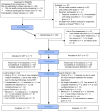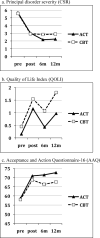Randomized clinical trial of cognitive behavioral therapy (CBT) versus acceptance and commitment therapy (ACT) for mixed anxiety disorders
- PMID: 22563639
- PMCID: PMC4718567
- DOI: 10.1037/a0028310
Randomized clinical trial of cognitive behavioral therapy (CBT) versus acceptance and commitment therapy (ACT) for mixed anxiety disorders
Abstract
Objective: Randomized comparisons of acceptance-based treatments with traditional cognitive behavioral therapy (CBT) for anxiety disorders are lacking. To address this gap, we compared acceptance and commitment therapy (ACT) to CBT for heterogeneous anxiety disorders.
Method: One hundred twenty-eight individuals (52% female, mean age = 38, 33% minority) with 1 or more DSM-IV anxiety disorders began treatment following randomization to CBT or ACT; both treatments included behavioral exposure. Assessments at pre-treatment, post-treatment, and 6- and 12-month follow-up measured anxiety-specific (principal disorder Clinical Severity Ratings [CSRs], Anxiety Sensitivity Index, Penn State Worry Questionnaire, Fear Questionnaire avoidance) and non-anxiety-specific (Quality of Life Index [QOLI], Acceptance and Action Questionnaire-16 [AAQ]) outcomes. Treatment adherence, therapist competency ratings, treatment credibility, and co-occurring mood and anxiety disorders were investigated.
Results: CBT and ACT improved similarly across all outcomes from pre- to post-treatment. During follow-up, ACT showed steeper linear CSR improvements than CBT (p < .05, d = 1.26), and at 12-month follow-up, ACT showed lower CSRs than CBT among completers (p < .05, d = 1.10). At 12-month follow-up, ACT reported higher AAQ than CBT (p = .08, d = 0.42; completers: p < .05, d = 0.56), whereas CBT reported higher QOLI than ACT (p < .05, d = 0.42). Attrition and comorbidity improvements were similar; ACT used more non-study psychotherapy at 6-month follow-up. Therapist adherence and competency were good; treatment credibility was higher in CBT.
Conclusions: Overall improvement was similar between ACT and CBT, indicating that ACT is a highly viable treatment for anxiety disorders.
(PsycINFO Database Record (c) 2012 APA, all rights reserved).
Figures
References
-
- Addis AE, Hatgis C, Bourne L, Krasnow AD, Jacob K, Mansfield A. Effectiveness of Cognitive–Behavioral Treatment for Panic Disorder Versus Treatment as Usual in a Managed Care Setting. Journal of Consulting and Clinical Psychology. 2004;72(4):625–635. - PubMed
-
- Arch JJ, Craske MG. Acceptance and commitment therapy and cognitive behavioral therapy for anxiety disorders: Different treatments, similar mechanisms? Clinical Psychology: Science and Practice. 2008;15(4):263–279.
-
- Barlow DH. Anxiety and its disorders: The nature and treatment of anxiety and panic. 2nd. New York, NY: Guilford Press; 2002.
-
- Barlow DH, Cerny JA. Psychological treatment of panic. New York, NY: Guilford Press; 1988.
-
- Barlow DH, Gorman JM, Shear MK, Woods SW. Cognitive-behavioral therapy, imipramine, or their combination for panic disorder: A randomized controlled trial. Journal of the American Medical Association. 2000;283(19):2529–2536. - PubMed
Publication types
MeSH terms
Grants and funding
LinkOut - more resources
Full Text Sources
Medical
Miscellaneous



